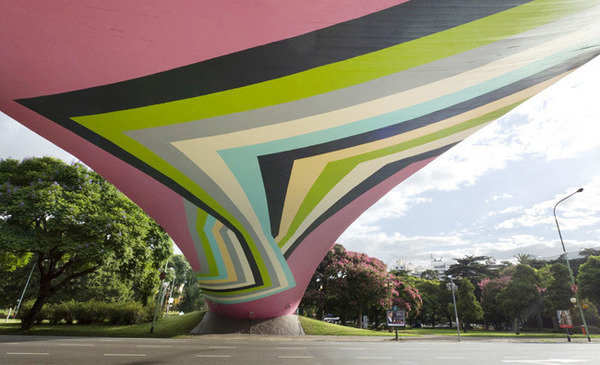Lang/Baumann
dal 27/4/2011 al 3/6/2011
Segnalato da
27/4/2011
Lang/Baumann
Galerie Loevenbruck, Paris
Sabina Lang and Daniel Baumann were born in the early 1970s and have been working together for a decade now. Their instantly recognisable signature, L/B, serves as a kind of trademark, 'a sign indicating control', as one might concisely define it. But L/B does not stand for one of those impeccably marketed art multinationals that market their spin-offs in all the right emporia; rather, this is little family firm that jealously guards the secrets of its production.

Sabina Lang and Daniel Baumann were born in the early 1970s and have been wor-
king together for a decade now. Their instantly recognisable signature, L/B, serves as a kind of
trademark, “a sign indicating control”, as one might concisely define it. But L/B does not stand
for one of those impeccably marketed art multinationals that market their spin-offs in all the
right emporia; rather, this is little family firm that jealously guards the secrets of its produc-
tion. And their production is meticulous, not something rattled off on a frantic assembly line;
it is made to measure, and nothing is subcontracted. It all starts in an old factory in Burgdorf,
a small town in German-speaking Switzerland where green pastures and industry cohabit.
The place is a cooperative, combining production, design and family life. Some may consider
the model a bit shop-worn and unproductive, but for Sabina Lang and Daniel Baumann this
is where they work towards the modestly utopian construction of a world that is more beau-
tiful, gentler, rounder and more colourful, while at the same time elaborating their radical and
rigorous art.
They are relaxed about embracing the forms and motifs of their childhood, those
of the 1960s, without lapsing into nostalgia or reaction. References to the past are part of a
strategy based on using familiar signs that link simultaneously to personal experience and
the collective imagination. The artists seem to share the spirit of that age in which faith in
the future and the breaking down of barriers between artistic disciplines combined with an
uninhibited assimilation of popular culture; a time when music, architecture, art, design and
social sciences moved forward together to the benefit of art. L/B respond to the disenchant-
ment of the noughties with their “beautiful entrance”, their “beautiful walls”, their “beautiful
lounges”, their “beautiful windows” and their “Spielfeld” (play area). For them, designing a bar,
a table football set, a snooker table or even a hotel room holds the promise of a unique aes-
thetic experience. Touching, using or inhabiting their spaces – their works are like invitations
addressed to the spectator. The relational codes pertaining to relaxation, well-being and play
are not an end in themselves but a simple and fresh means of access to the work through
hedonistic exchange.
The materials and forms are chosen for the visual and functional qualities. The carpeting is
soft, and has a considerable effect on the acoustics. The bright, plastic surfaces change the
way we perceive dimensions and distances. The wall paintings and installations favour over-
looking views, angles and kinetic motifs in order to heighten the effect of disorientation. L/B
work by covering over what already exists (walls, roads, sports grounds). They act on the sur-
face. Their all-over practice allows them to go beyond the wall as exhibition area and make
free use of the floor, ceiling and furniture in their conception of environments. Their “beautiful
walls” enact the transition from surface to volume, from two dimensions to three-dimensional
space.
Neither besotted nor blind, Lang and Baumann are very much artists of their times.
They perfectly master the potential of the forms they use and articulate their social and
political corollaries (a wind of freedom and a belief in the capacity of politics to change so-
ciety). Where design plays on seriality and wide distribution, L/B propose works that inflect
commercial logics. The Hotel Everland consists of a single room. To reserve it, a potential client
will have more need of persistence than of money. Where architecture is built and conceived
in the long term, L/B’s environments place the emphasis on ephemeral forms linked to pre-
existing architectural spaces, notably the white cube.
In materialising their pragmatic vision of exhibition spaces and their habitability, L/B dispel all
ambiguity: for them, the everyday experience of architecture and design will always be an art,
and not a function in lieu of an eventual utopia.
Yann Chevallier, T(e)xtes, éditions Loevenbruck, Paris 2009.
Sabina Lang (born 1972 in Bern, Switzerland) and Daniel Baumann (born 1967 in San Francisco, CA, USA) live and work in Burgdorf, Switzer-
land.
Recent exhibitions: 2010, Street Painting #5, R & Art, Vercorin, Switzerland; Lang/Baumann, Galeria Foksal, Warsaw, Poland; 2009, I’m Real,
Urs Meile Gallery, Beijing, China; 2007-2009, Hotel Everland, Palais de Tokyo, Paris. Monumental works by Lang/Baumann have featured
in the following recent group shows: 2011, Luftkunst, Zeppelin Museum, Friedrichshafen, Germany; Of Bridges & Borders, Fundacion Proa
& Puente Figueroa Alcorta, Recoleta, Buenos Aires, Argentina; 2010, Regionale. Fabricators of the World. Scenarios of Self-Will, Trautenfels
Castle, Pürgg-Trautenfels, Austria, Fukutake House, Setouchi International Art Festival 2010, Kagawa, Japan. Works by Lang/Baumann
are held in numerous public collections in Switzerland. In France, their installation Street Painting #4 (2010) entered the Fonds Municipal
d’Art Contemporain, Paris, in 2010 and their sculpture Childish Behavior #3 (2000) was acquired by the Fonds National d’Art Contemporain
in 2009.
Press contact
Alexandra Schillinger, alexandra@loevenbruck.com, t 01 82 28 38 22,
assisted by Clio Lavau, factory@loevenbruck.com
Private view Thursday 28 April 2011, from 6 pm
Galerie Loevenbruck
6, rue Jacques Callot - Paris
Opening hours: Tues-Sat, 11 a.m. - 7 p.m. and by appointment



